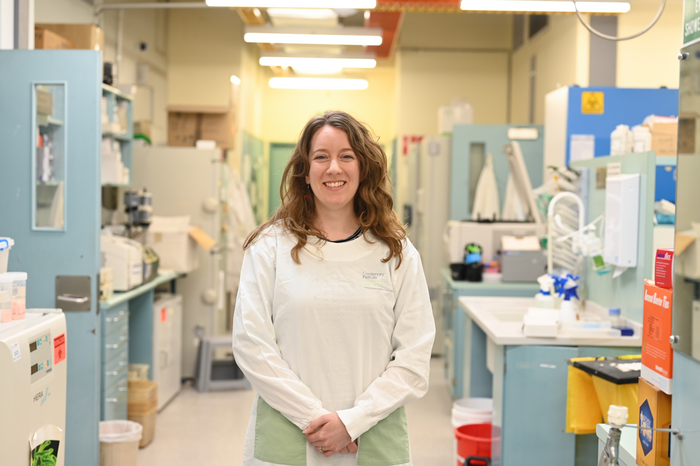New nasal vaccine strategy revolutionizes COVID-19 protection
The emergence of SARS-CoV-2 in late 2019 and the subsequent global COVID-19 pandemic has led to substantial morbidity and mortality.

[Nov 18, 2022: Anthony Crawshaw, Centenary Institute]
Dr Anneliese Ashhurst, University of Sydney and Centenary Institute. (CREDIT: Centenary Institute)
The emergence of SARS-CoV-2 in late 2019 and the subsequent global COVID-19 pandemic has led to substantial morbidity and mortality with currently over 600 million confirmed cases and 6.5 million deaths reported to the World Health Organisation. The development of vaccines against SARS-CoV-2 has reduced the morbidity and mortality associated with COVID-19 and limited the significant disruption to economies and freedom of movement arising from restrictive, but necessary, public health measures.
Researchers from the Centenary Institute and the University of Sydney have developed a new nasal vaccination strategy that induces potent lung immunity and protection against the SARS-CoV-2 coronavirus.
The new vaccine approach has been tested successfully in mice and has the potential to be a powerful tool for enhancing protection against COVID-19 infection and minimising ongoing viral spread.
Made up of the SARS-CoV-2 spike protein and an adjuvant called Pam2Cys (a molecule that helps stimulate a stronger immune response in the body), that was developed by Professor Richard Payne, NHMRC Investigator in the University of Sydney’s Faculty of Science, the new vaccine was delivered via simply breathing in through the nose. It prompted substantial levels of neutralising antibodies and increased T-cell responses in the lungs and airways of the mice that were tested.
Related Stories:
Lead author of the study, Dr Anneliese Ashhurst, research fellow in the University of Sydney’s Faculty of Medicine and Health and the Centenary Institute said that while current COVID-19 vaccines are critical, there were some limitations, including the waning of immunity post-vaccination and infection, combined with the impact of new viral variants evolving.
“Current vaccines against SARS-CoV-2 substantially reduce mortality and severe disease, but protection against infection is less effective. Vaccinated individuals are still catching COVID-19 and can spread the infection, so breakthrough infections are still occurring,” said Dr Ashhurst.
“To stop viral spread and to prevent this virus from mutating we need a new vaccine approach that blocks COVID-19 transmission,” she said.
Dr Anneliese Ashhurst, University of Sydney and Centenary Institute. (CREDIT: Centenary Institute)
In the mice study, the new vaccine was delivered nasally, making its way through the respiratory tract, adhering to the tissues of the nasal cavity, airways and lungs. Testing showed the generation of high levels of protective antibodies in the airways and increased T-cell responses in the lungs (T-cells help destroy SARS-CoV-2 infected cells). Significantly, none of the vaccinated mice became infected with COVID-19.
“Our vaccine differs from most current COVID-19 vaccines in that it enables generation of an immune response directly in those areas of the body that are likely to be the first point of contact for the virus – the nose, airway and lungs. This may help explain the vaccine’s effectiveness,” said Dr Ashhurst.
Professor Warwick Britton AO, Centenary Institute. (CREDIT: Centenary Institute)
Senior study author, Professor Emeritus Warwick Britton AO, Head of the Centenary Institute’s Tuberculosis Research Program, said that the new vaccine strategy could play a key role in the fight against many diseases.
“Our vaccination findings have shown exciting potential in pre-clinical studies, improving protection against SARS-CoV-2 infection. The approach developed here could help break the COVID-19 infection cycle and will likely influence future coronavirus vaccine related studies,” Professor Britton said.
Vaccination with Pam2Cys Spike induces potent Spike-specific neutralizing antibody responses, which is enhanced in the airways with mucosal vaccination. (CREDIT: Nature Communications)
He added that adapted versions of the new nasal vaccine could also be potentially applied to other viral or bacterial respiratory diseases such as influenza, avian flu, SARS and MERS.
The study was published in the prestigious journal Nature Communications.
About the Centenary Institute
The Centenary Institute is a world-leading independent medical research institute, closely affiliated to the University of Sydney and the Royal Prince Alfred Hospital. Our research focuses on three key areas: cancer, inflammation and cardiovascular disease. Our strength lies in uncovering disease mechanisms and applying this knowledge to improve diagnostics and treatments for patients.
For more science and technology stories check out our New Discoveries section at The Brighter Side of News.
Note: Materials provided above by Centenary Institute. Content may be edited for style and length.
Like these kind of feel good stories? Get the Brighter Side of News' newsletter.
Joseph Shavit
Head Science News Writer | Communicating Innovation & Discovery
Based in Los Angeles, Joseph Shavit is an accomplished science journalist, head science news writer and co-founder at The Brighter Side of News, where he translates cutting-edge discoveries into compelling stories for a broad audience. With a strong background spanning science, business, product management, media leadership, and entrepreneurship, Joseph brings a unique perspective to science communication. His expertise allows him to uncover the intersection of technological advancements and market potential, shedding light on how groundbreaking research evolves into transformative products and industries.



